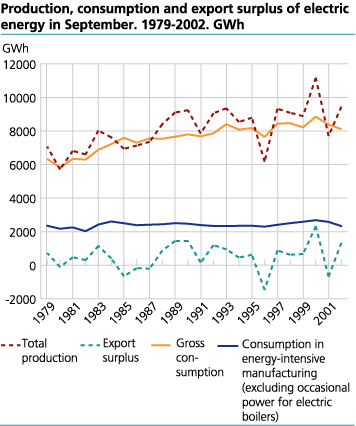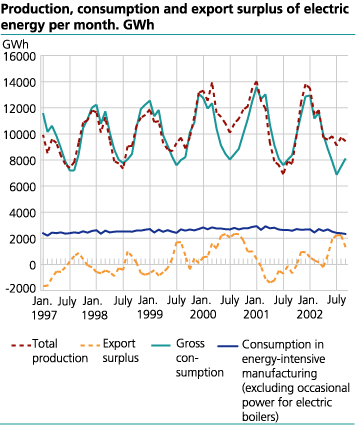Content
Published:
This is an archived release.
Still high production of electric energy
The producers of electric energy maintained the high production in September. The rainfall was below normal and the water reservoirs that normally are filled up in September were reduced by 2 per cent.
The production of electricity was 23.8 per cent higher than September last year, and 6.8 per cent higher than the average for this month the last ten years. The export of 1 484 GWh is the second highest recorded for this month. The rainfall was 12 per cent below the normal.
The last months the production and the export of electric energy have been high compared to previous years. For the period July-September the production was 12.2 per cent higher than the average the last ten years and the export was doubled in the same period. High production and rainfall below normal has led to reservoirs levels below the median. When the reservoirs levels are low this will lead to expectations of higher value of the water in the future and thereby also higher prices today.
In the period July-September the trickle of water was 29 TWh this year, and 37 TWh last year. In the same period the net import was 1 498 GWh last year, and a net export of 5 811 GWh this year. The variations make it difficult to decide the normal production and export of electric energy. When a producer chooses a production strategy he knows today's reservoirs levels and other hydrologic circumstances, today's prices (the spot price), and the markets expectations for the future prices (term prices). This implicates that the producer will sell today if the price obtained in the spot market is higher than the prices he can obtain in contracts for delivery in the future (term contracts). If the term prices are higher it is in general rational to hold back water for delivery of electricity in the future to a agreed price today. This is not the situation for producers with no reservoir capacity. In July and August the winter term prices were considerable higher than the spot prices. When producers still choose a high production this must be due to other causes. In principle there are no costs storing the water. But the prices will decrease with high reservoirs levels, and water that flows out will not be used. The price fall can be secured in term contracts, but they cannot secure the eventual loss of water.
In the Norwegian water power system 84.1 TWh can be stored in reservoirs. In a normal year with much rain in the autumn the reservoirs will reach the maximum level in mid-October. The median for week 42 is 90.4 per cent of the capacity, while the level was 78.6 this year.
Consumption down
September was the ninth month in a row with lower gross domestic consumption compared with last year. The consumption was 8 110 GWh, which is down 3.2 per cent compared with the same month last year. The consumption has not been this low for this month since 1996. It is the fall in energy-intensive industry that explains most of the reduction. The export from Norwegian water power production has mainly covered a reduction in the Swedish water power production without equivalent reduction in the Nordic demand for electric energy. Swedish water power producers have in a larger extent held back production and water in the reservoirs.
See also
Tables:
Contact
-
Magne Holstad
E-mail: magne.holstad@ssb.no
tel.: (+47) 40 90 23 42
-
Ingvild Røstøen Ruen
E-mail: ingvild.ruen@ssb.no
tel.: (+47) 40 81 13 97
-
Tom Jonas Billit
E-mail: tom.billit@ssb.no
tel.: (+47) 40 81 13 45
-
Thomas Aanensen
E-mail: thomas.aanensen@ssb.no
tel.: (+47) 40 90 23 48


